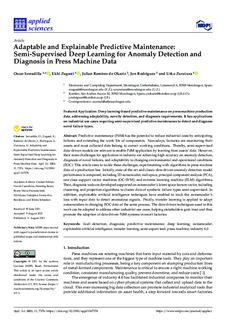Título
Adaptable and Explainable Predictive Maintenance: Semi-Supervised Deep Learning for Anomaly Detection and Diagnosis in Press Machine DataFecha de publicación
2021Otras instituciones
Koniker, S. Coop.Versión
Version publicadaTipo de documento
ArtículoArtículoIdioma
InglésDerechos
© 2021 by the authors. Licensee MDPIAcceso
Acceso abiertoVersión de la editorial
https://doi.org/10.3390/app11167376Publicado en
Applied Sciences Vol. 11. N. 16. N. artículo 7376, 2021Editorial
MDPIPalabras clave
fault detection
diagnosis
predictive maintenance
deep learning ... [+]
diagnosis
predictive maintenance
deep learning ... [+]
fault detection
diagnosis
predictive maintenance
deep learning
autoencoder
Explainable Artificial Intelligence
transfer learning
semi-supervised
press machine
Industry 4.0 [-]
diagnosis
predictive maintenance
deep learning
autoencoder
Explainable Artificial Intelligence
transfer learning
semi-supervised
press machine
Industry 4.0 [-]
Resumen
Predictive maintenance (PdM) has the potential to reduce industrial costs by anticipating failures and extending the work life of components. Nowadays, factories are monitoring their assets and most c ... [+]
Predictive maintenance (PdM) has the potential to reduce industrial costs by anticipating failures and extending the work life of components. Nowadays, factories are monitoring their assets and most collected data belong to correct working conditions. Thereby, semi-supervised data-driven models are relevant to enable PdM application by learning from assets’ data. However, their main challenges for application in industry are achieving high accuracy on anomaly detection, diagnosis of novel failures, and adaptability to changing environmental and operational conditions (EOC). This article aims to tackle these challenges, experimenting with algorithms in press machine data of a production line. Initially, state-of-the-art and classic data-driven anomaly detection model performance is compared, including 2D autoencoder, null-space, principal component analysis (PCA), one-class support vector machines (OC-SVM), and extreme learning machine (ELM) algorithms. Then, diagnosis tools are developed supported on autoencoder’s latent space feature vector, including clustering and projection algorithms to cluster data of synthetic failure types semi-supervised. In addition, explainable artificial intelligence techniques have enabled to track the autoencoder’s loss with input data to detect anomalous signals. Finally, transfer learning is applied to adapt autoencoders to changing EOC data of the same process. The data-driven techniques used in this work can be adapted to address other industrial use cases, helping stakeholders gain trust and thus promote the adoption of data-driven PdM systems in smart factories. [-]
Sponsorship
Diputación Foral de GipuzkoaID Proyecto
info:eu-repo/grantAgreement/EC/H2020/825030/EU/Digital Reality in Zero Defect Manufacturing/QU4LITYColecciones
- Artículos - Ingeniería [763]
El ítem tiene asociados los siguientes ficheros de licencia:






















